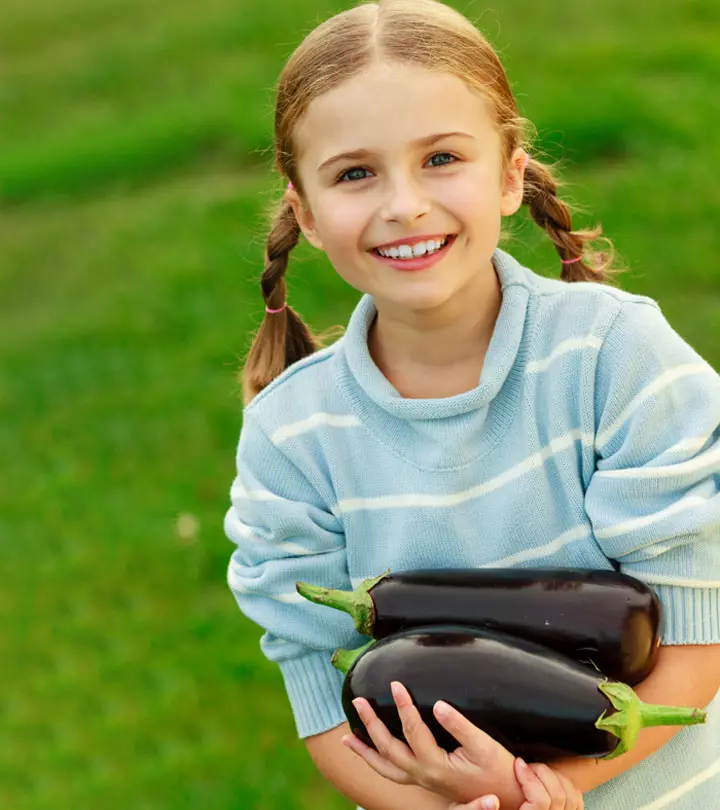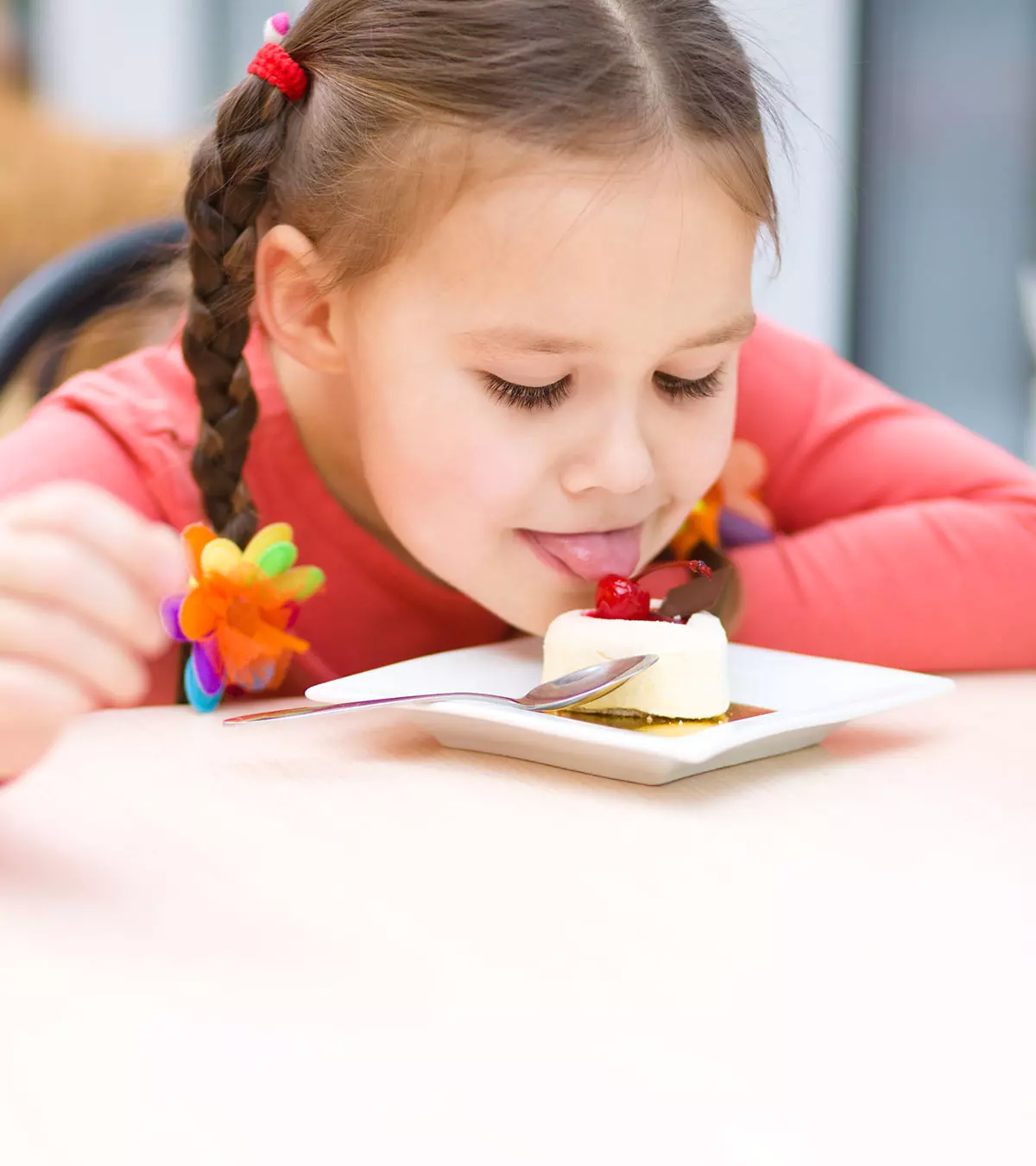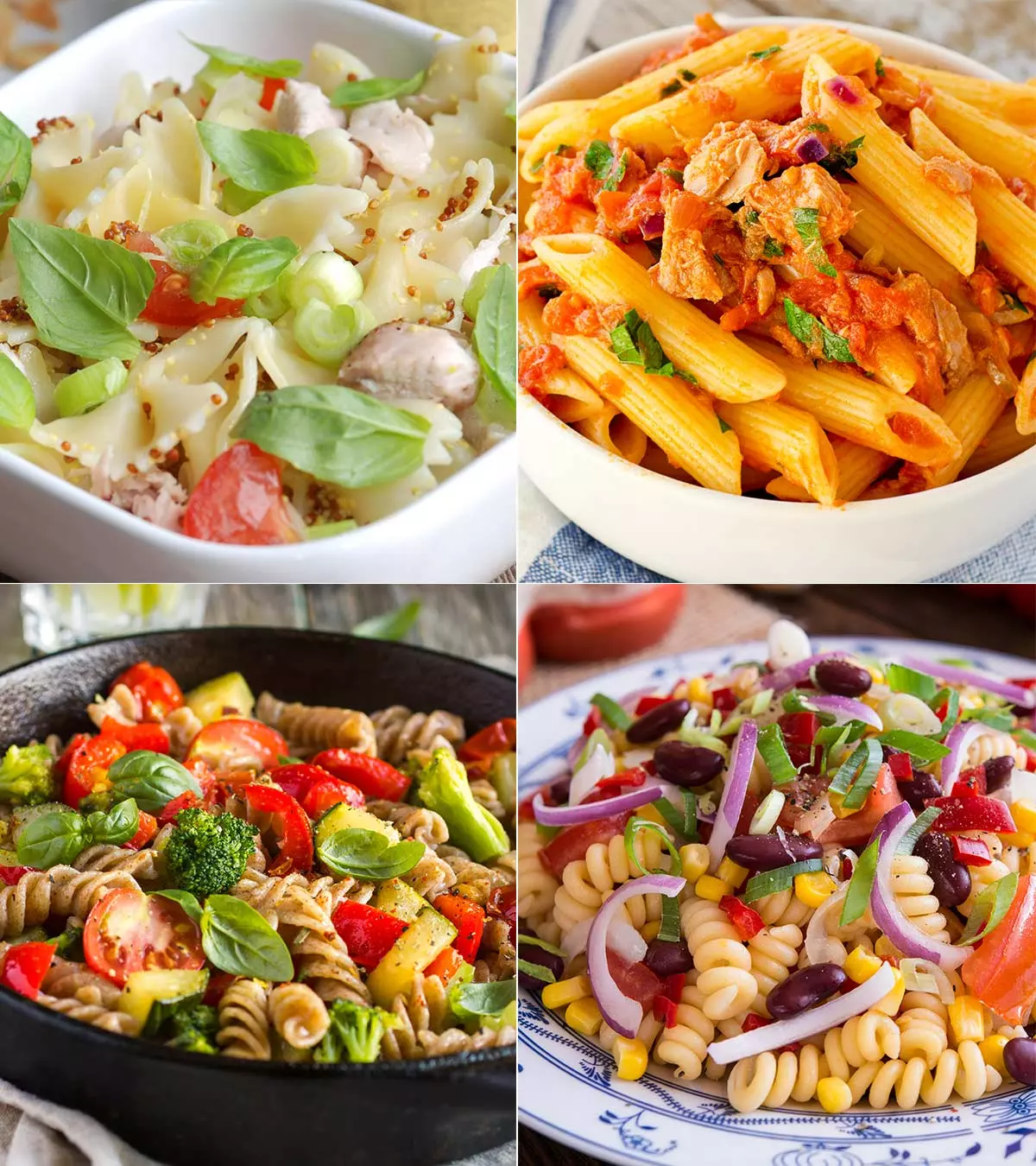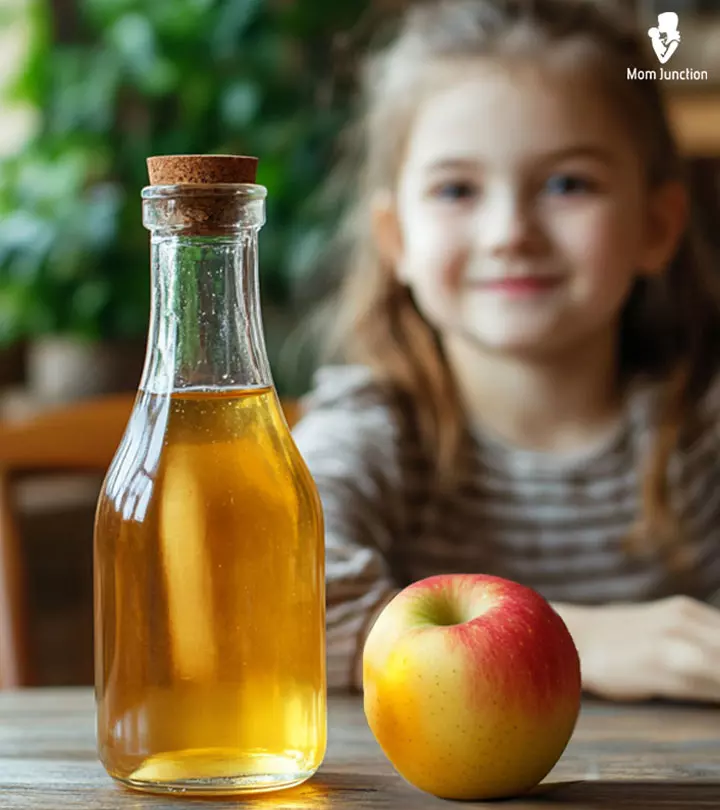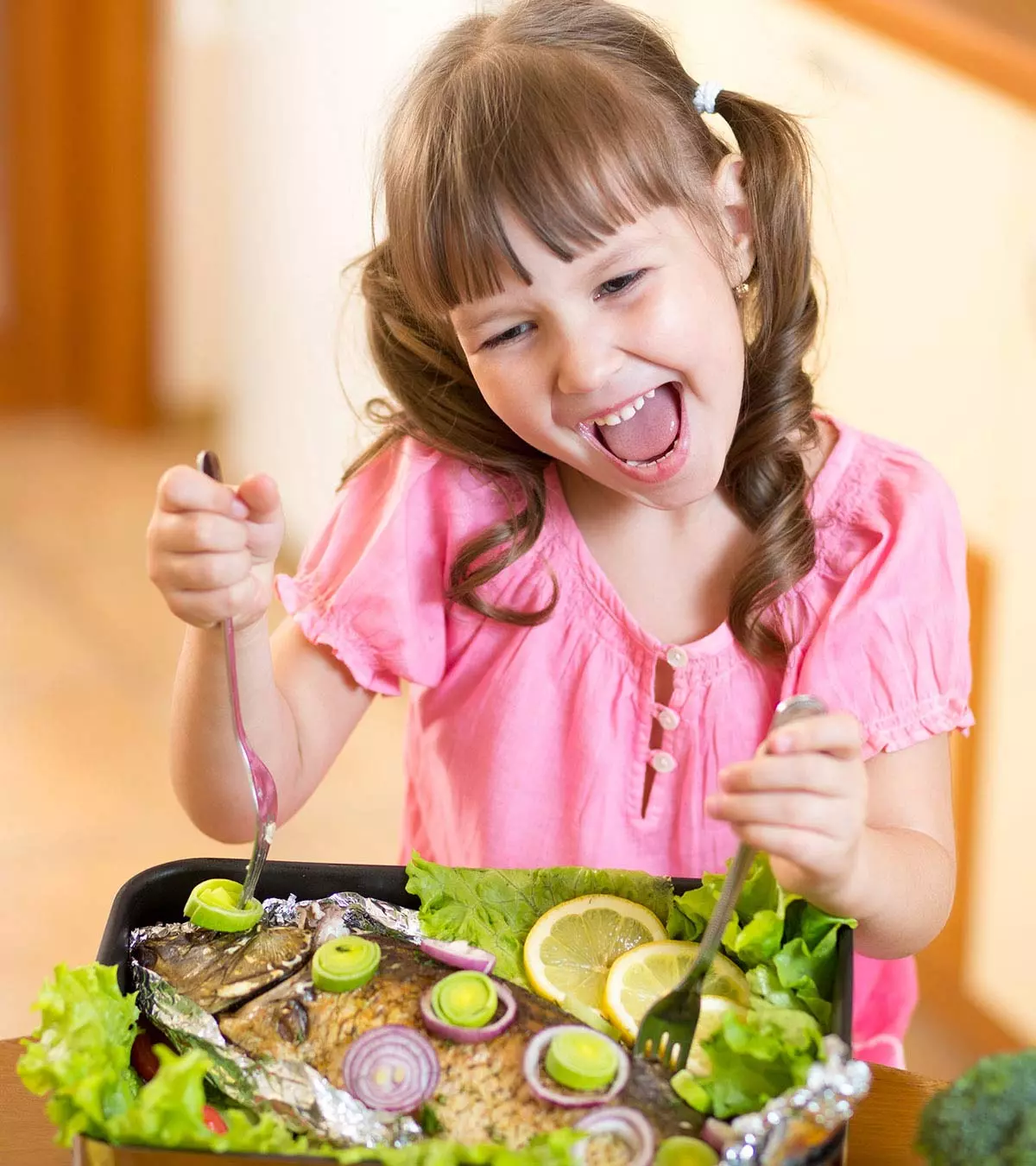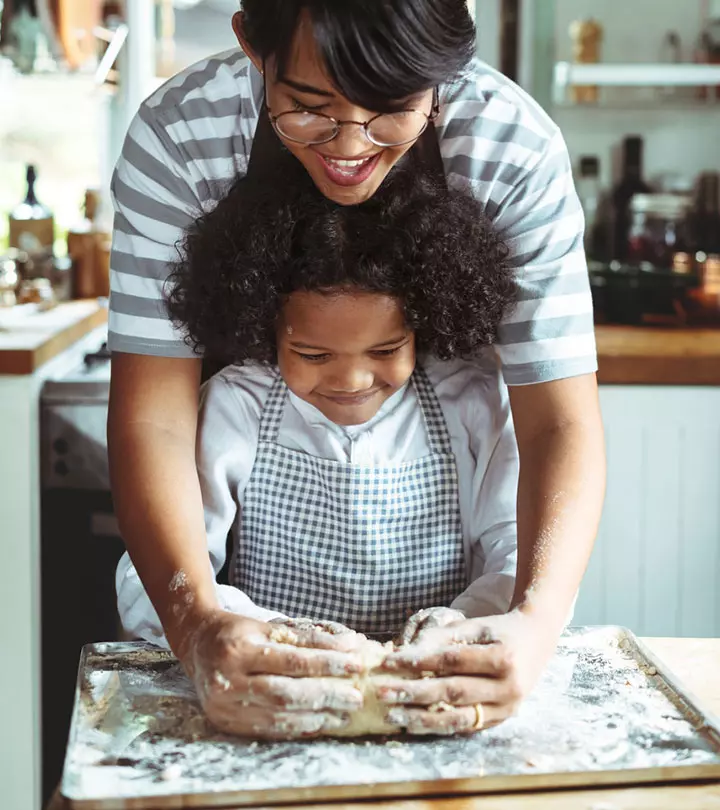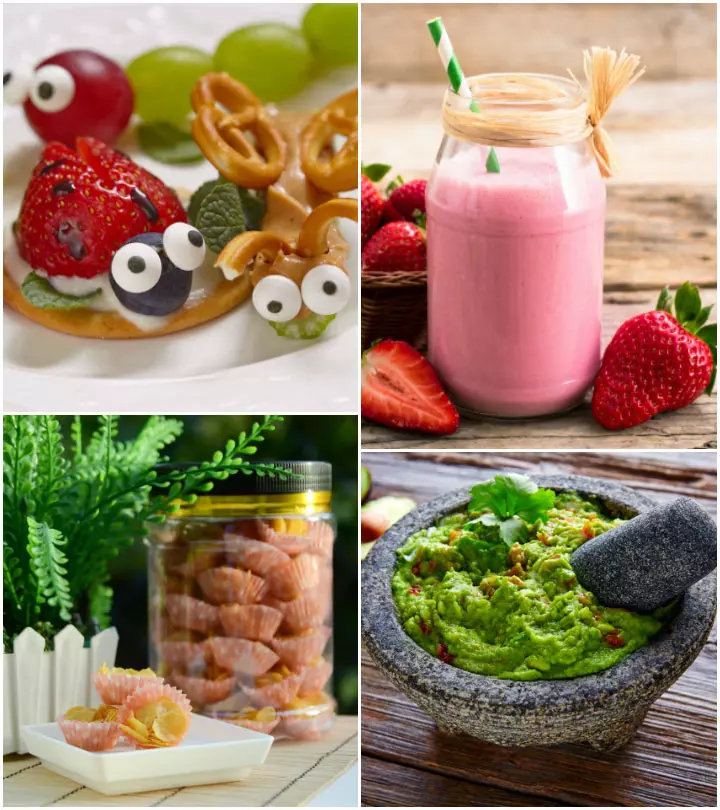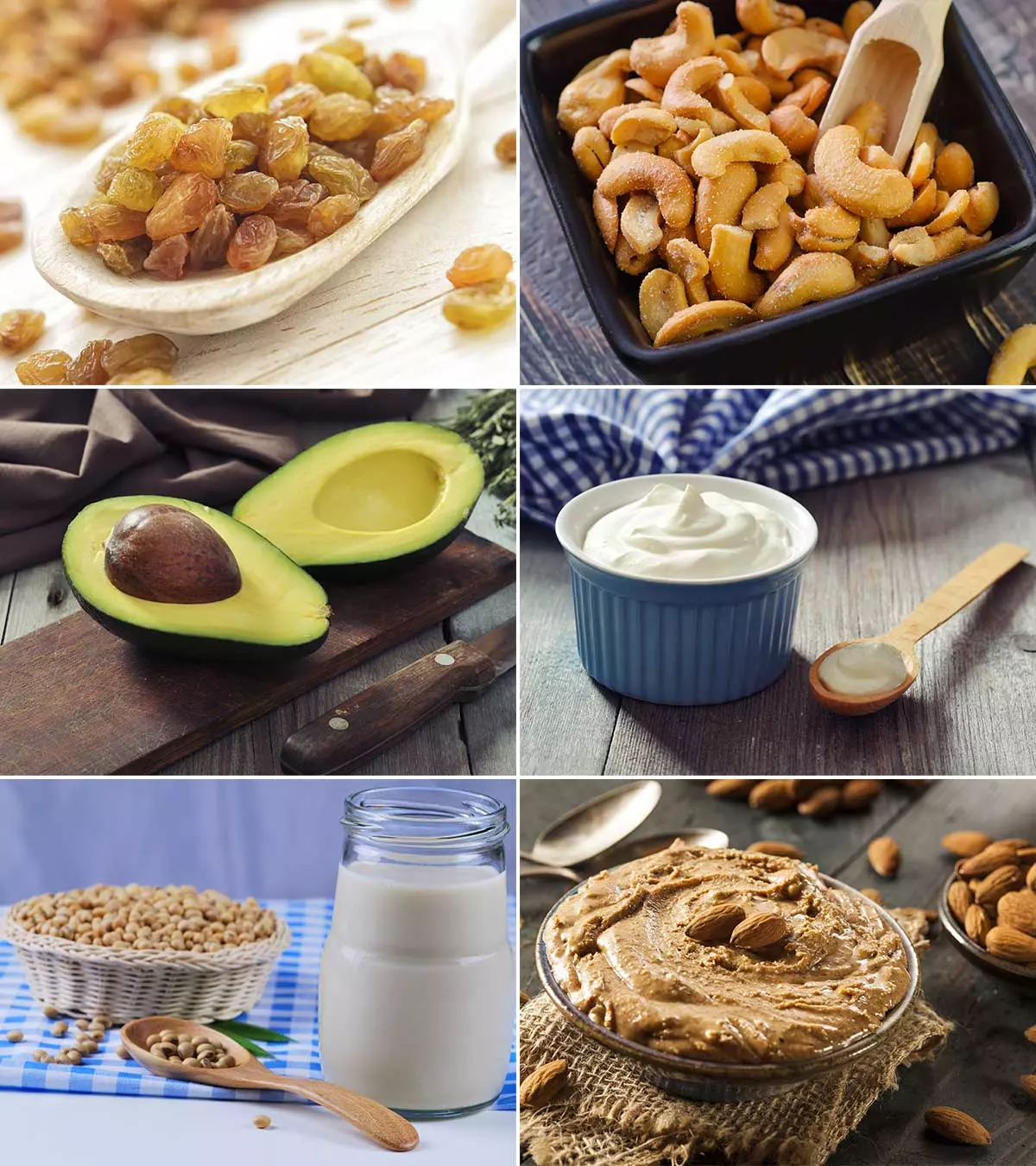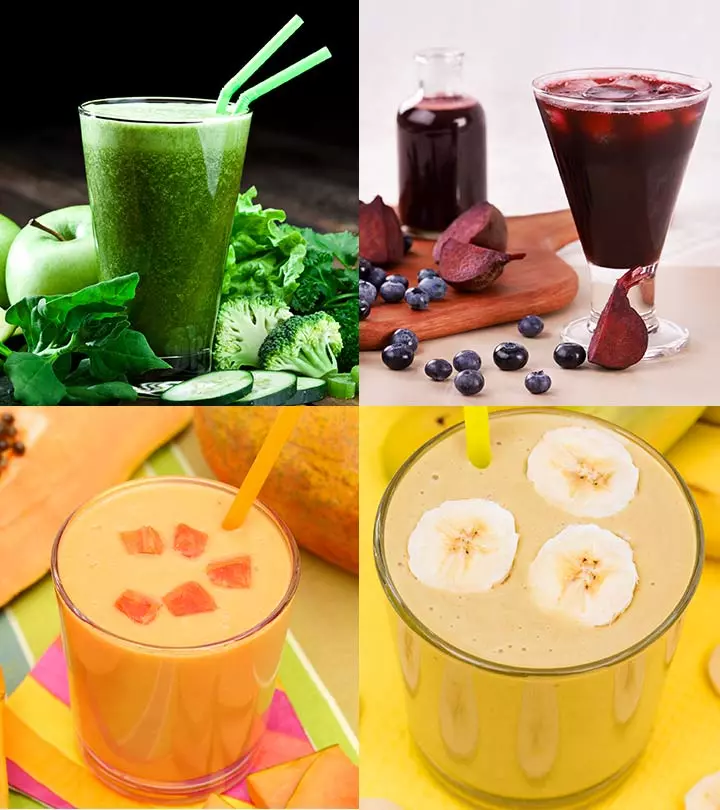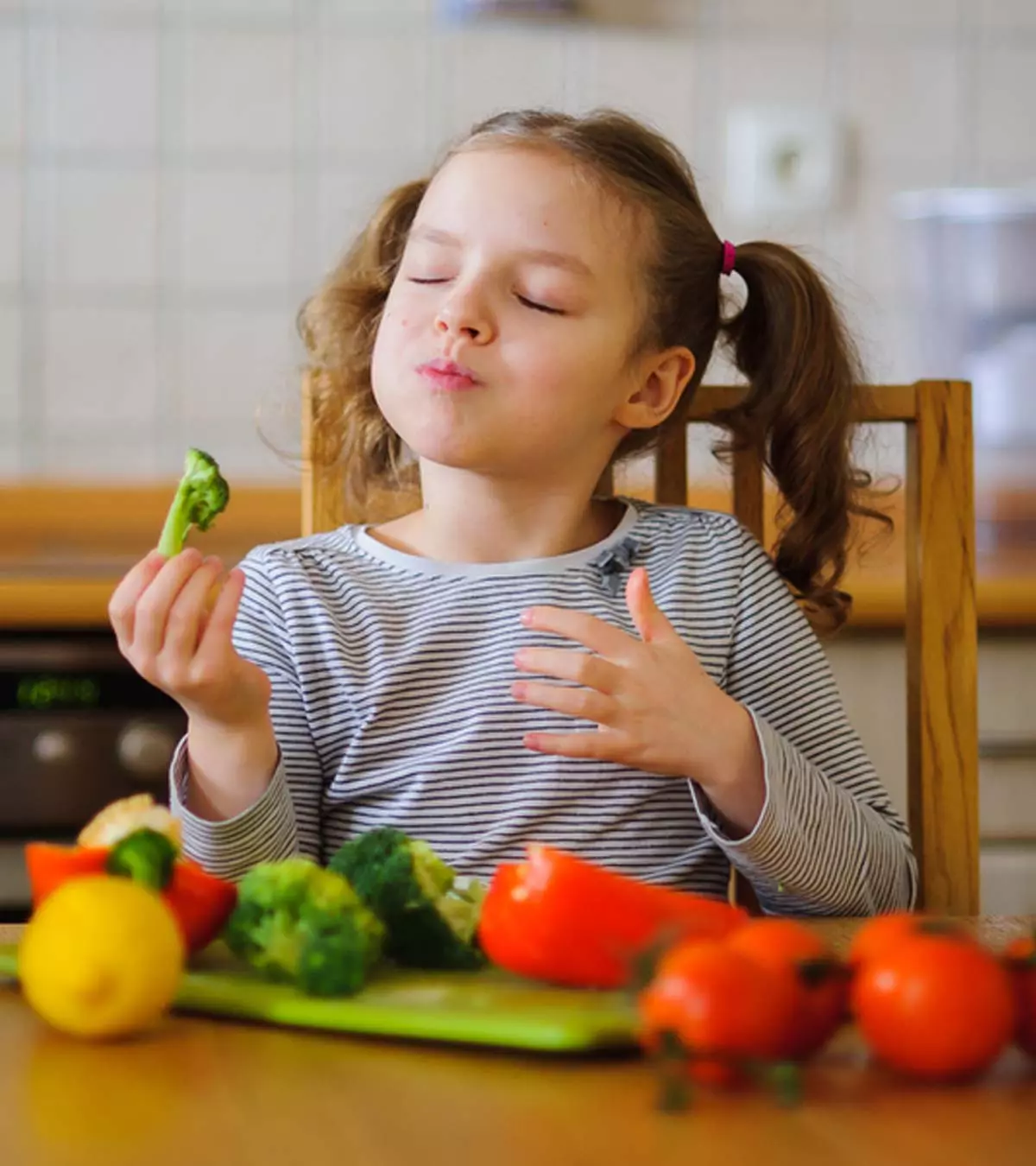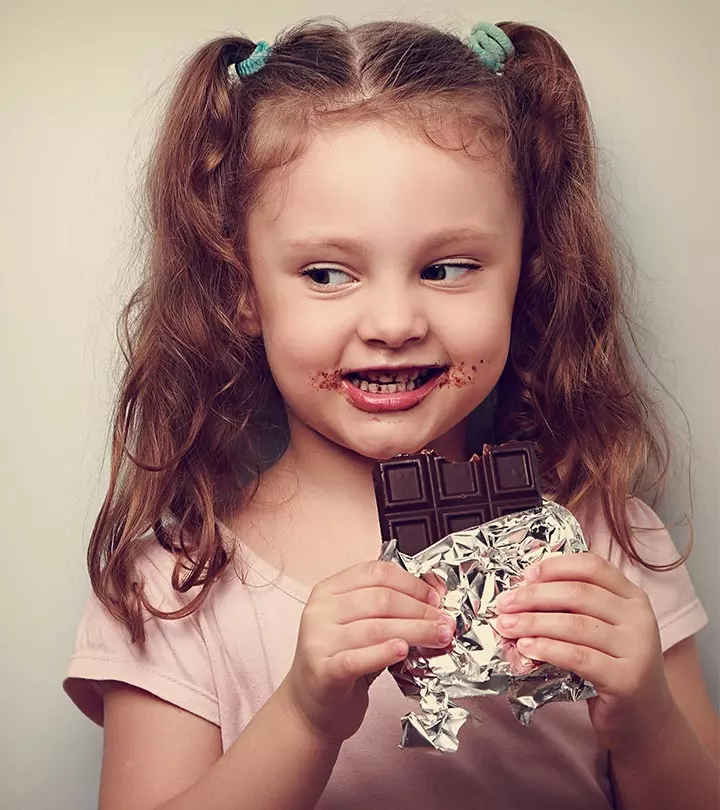
Image: ShutterStock
“There is nothing better than a friend unless it is a friend with chocolate.” – Charles Dickens

If you ask children what they like to eat, many will say chocolate. Chocolate for kids is a delicious treat that they happily gobble down. Be it chocolate candy bars, icecreams, lollipops, brownies, muffins, slushies, gummies, doughnuts, puddings, or a cup of hot chocolate, most children love relishing chocolate in every form possible. They love it so much that the market is flooding with chocolate-flavored foods in the form of desserts, sweets, and beverages, attracting children and adults alike.
If your child is a chocolate lover, they would love to know more about the world of chocolate, including its origin. So, feed their curiosity with some interesting and fun facts about chocolate shared in this post. This post offers insight into the world of chocolate, the types of chocolates, their benefits and side effects, and healthy alternatives.
Key Pointers
- Cacao seeds are dried and roasted to become cocoa beans for chocolate production.
- Chocolate may have been used as currency by The Mayans and the Aztecs as early as 1700 BC.
- The term “Chocolate” comes from the Mayan word “Chocol,” meaning hot drink.
- Kids can enjoy moderate amounts of chocolate and benefit from stress relief, lower blood pressure, plaque reduction, antioxidants, and improved cardiovascular health.
- Overindulging in chocolate can lead to weight gain, headaches, ADHD, and high sugar intake.
Where Does Chocolate Come From?
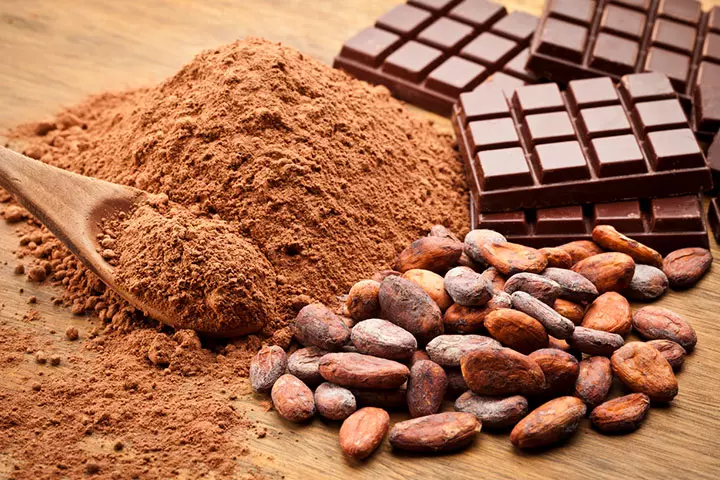
Chocolate is made from cocoa beans, which are fermented, dried, and roasted cacao seeds, or seeds of the cacao plant. The seeds from the cacao pods are carefully removed and left exposed to light to let them ferment for around nine days or less. Once that is done, they are dried for a week or two under the hot sun, then roasted and blended to make the cocoa powder that is used for making chocolate.
The history of chocolate is long and goes back to thousands of years. The first known use of chocolate was in 1900 BC, more than 3,500 years before Nestlé set up his chocolate manufacturing unit. Only at that time, it was not called chocolate.
Archeological findings suggest civilizations that flourished in Mesoamerica, during the Early Formation period, may have used the bittersweet beans from the cacao trees in their beverages. The findings suggest that people knew how to make chocolate from the cacao seeds way back in 1700 BC (1). Evidence found in the vessels used by these civilizations proves that people often used chocolate in their drinks, possibly fermented.
The Mayans and the Aztecs may also have used cacao seeds in some important rituals. They made a drink with it and called it ‘chocolatl’. They considered the seeds so precious that they may have been used as currency for trade, while the drink made from it was considered the ‘food of Gods’. Only the wealthy Mayans who had enough cacao seeds to spare enjoyed the drink.
Chocolate found its way into Europe when Columbus brought cacao seeds back with him to Spain, and presented them as a treasure to King Ferdinand. Two centuries later, an Englishman called Joseph Fry made the first solid chocolate. About 25 years after that, Henri Nestlé made the first chocolate bar using condensed milk. And the rest, as they say, is history!
Fun Chocolate Facts For Kids
Here are some really interesting facts about chocolate for kids.
- The word chocolate is derived from the Mayan word ‘Chocol,’ meaning a hot drink. The bitter, hot drink was called ‘Xacoatl’ by the Aztecs.
- Chocolate was once considered more valuable than gold dust. Imagine that!
- The scientific name of the cocoa plant is Theobroma cacao, where Theobroma means ‘food of the Gods’.
- A real chocolate river was created using water, chocolate, and cream for the movie Willy Wonka and the Chocolate Factory. It stunk after a few days!
- White chocolate is not chocolate because it contains no cocoa solids.

- Ruth Wakefield created the first chocolate chip cookie in 1930, by accident. She gave the recipe to Nestle` in return for a lifetime supply of chocolate. Now that’s an interesting chocolate story for kids!
- During the revolutionary war, a few soldiers were paid in chocolate!
- Montezuma, the Aztec emperor, consumed 50 goblets of chocolate every day.
- Do you know why chocolate melts in your mouth? Because it is the only food that melts at 93 degrees Fahrenheit, below the average human body temperature.
- The Aztecs and the Mayans used chocolate drink as a stress reliever, way before the term ‘stress’ was coined!
- A tiny chocolate chip can give you enough energy to walk 150 feet.
- The smell of chocolate is enough to relax you! Apparently, the scent of chocolate increases theta brain waves that aid in relaxation. No wonder people tend to eat chocolate when they have problems.
- The shape of the cacao pod looks similar to a football, and it grows straight out from the branches.
- Chocolate contains an enzyme called phenylethylamine, which releases the ‘pleasure’ hormones in the brain, a feeling akin to being ‘in love’.
- The world’s biggest chocolate bar weighed 12,770 lbs.
- Chocolate-dipped potato chips exist, for real!
- Chocolate can be fatal to dogs and cats.
- Belgium issued limited edition chocolate-flavored stamps in 2013.
- An average American consumes almost 4.5kg of chocolate every year.
Interesting Information About Chocolate For Kids
Fun facts aside, here is some really interesting information about chocolate and its production. Your children would love to know about it.
- Cacao trees can grow as old as 200 years, but they produce marketable kinds of cocoa beans only for the first 25 years of their life. In one year, a cacao tree produces around 2,000 pods.

- After the farmers pick the beans from the tree, they ferment and dry them. The process may take up to several weeks. After the seeds turn completely dry, the seed reaches the factory site where the manufacturers prepare chocolate through the specific recipe.
- Once the chocolate reaches the factory site, the beans are properly cleaned, sorted and weighed. Each of the distinct manufacturers utilizes a different amount and type of beans to prepare varied kinds of chocolate. Sometimes, the manufacturer may even require ten to twelve different kinds of beans to make some specific variation of chocolate.
- The entire process of manufacturing a chocolate candy or bar may take almost a week.
- Chocolate plants grow abundantly in Central and South America, but for commercial needs manufacturers also grow the trees throughout the tropical region.
- The pods mature slowly throughout the different times of the year. If the pod appears sticky and whitish, the seeds are very bitter in taste.
- Ivory Coast produces 40% of the world’s cocoa (cacao?) supply.
- Around 400 cacao beans are used to make one bar of chocolate.
Harvesting cacao is an ardent task and labor-intensive. Fair Trade practices are implemented to help cocoa farmers around the world get a better price for their product and make cocoa farming sustainable. Global brands like Cadbury, M&S, Divine Chocolate, RAWR, Sainsbury’s, Waitrose and Zotter chocolate are a few that encourage Fair Trade chocolate production.
Types Of Chocolate
Chocolate is loved in any form, shape, and concentration. But if you want to get into the details of the different varieties of chocolate, maybe for your child’s class essay on chocolate for kids, keep reading.
- Bittersweet chocolate contains raw chocolate, cocoa butter, and sugar in specific quantities to give a bitter and sweet taste in every bite. Dark chocolate is a type of bittersweet chocolate, also called semisweet chocolate.
- Technically, white chocolate is not chocolate as it does not contain cocoa, but it contains milk solids and sugar.
- Cacao powder is the powder of the cacao beans, minus the shell. It is used to make chocolate milk or hot cocoa drinks. It contains around 20% of fat from cacao butter.
- Chocolate liqueur is a smooth chocolate liquid, without alcohol. It is made by grinding the cacao beans into a smooth paste and contains over 50% cacao butter.
- Unsweetened chocolate is pure chocolate made by hardening chocolate liqueur and is often used in baking. It is also known as baking chocolate, pure chocolate or bitter chocolate.
- Ground chocolate is simply sweet chocolate powder, made by pounding a bar of chocolate. It is not to be confused with cacao powder.
Chocolate Milk For Kids

Besides nibbling on a bar of milk chocolate, kids also enjoy sipping a glass of hot or cold chocolate milk from time to time. If your little girl or boy enjoys drinking chocolate and overeating it, here is something you should know about it.
Is chocolate milk good for a kid? Yes, it is healthy, unless your child is lactose intolerant. Milk with chocolate powder is a great replacement for plain milk, as it has several nutrients that the kids need. Use raw, unsweetened cacao powder, which is healthier than using commercial chocolate powders.
Also, chocolate milk has less added sugar compared to other flavored milk drinks. What’s more, chocolate milk is a healthier, tastier replacement to sweetened beverages and sodas that add a lot of empty calories leading to weight gain.
Here is even better news: chocolate milk has 16 essential nutrients including proteins, vitamin A, B12, B6 and D, calcium, riboflavin, niacin, phosphorus, zinc, selenium, magnesium and folate among others. So the next time your child wants a drink, you know chocolate milk is the answer.
 Quick tip
Quick tipIs Chocolate Healthy For Kids?
Children love chocolate in any form: bar, drink, melted, frosted and even powdered. In fact, they love them so much that you can try some good chocolate recipes for kids learned by heart. That said, should kids be eating chocolate every day? Is chocolate milk for kids a good idea?
Well, the jury is out: Chocolate is not bad.
In fact, it has several health benefits, when consumed in moderation. Here are some.
- Chocolate is a stress reliever. Dark chocolate contains tryptophan and can improve your positive mood and keep you happy too (2).
- A Harvard study found that dark chocolate can lower blood pressure, especially among people with hypertension (3).
- As opposed to the common belief that chocolate is bad for kids, chocolate helps reduce the growth of plaque and prevents tooth decay.
- Chocolate comes from a plant and is also rich in nutrients. Dark chocolate contains minerals like iron, magnesium, copper, manganese, potassium, zinc and selenium.
- Dark chocolate has antioxidants that help fight the free radicals and keep diseases at bay.
- Research has proven that chocolate does not induce acne breakout. In fact, dark chocolate has compounds that are good for your teen’s skin.
- Similar to red wines and fruits, cocoa seeds contain a high percentage of antioxidants named flavonoids, which improves your kid’s cardiovascular health.
- Dark chocolate contains almost twice as many flavonoids as milk chocolates, but it contains more caffeine than other chocolates.
- Flavonoids present in cocoa products possess effective anti-clotting, antioxidant, and anti-inflammatory effects. They reduce the risk of diabetes in kids by improving insulin sensitivityiThe measure of the body's sensitivity to insulin's effects .
- Dark chocolate is also known to improve memory and concentration by activating the flavonoids in the hippocampus (4).
- Though chocolate and cocoa butter contain high levels of saturated and unsaturated fat, the stearic acid in chocolates acts as a neutral fat that does not raise your kid’s bad cholesterol levels.
- Chocolate acts as a stimulant and can give you energy. No wonder you reach out to a bar of chocolate when you are hungry and exhausted!
- Chocolate is also considered to have compounds that activate the body’s natural antidepressant, serotoniniA natural mood stabilizer and a chemical that conveys messages throughout the body . Dark chocolate for kids can keep them in a good mood.
Dark chocolate is healthier than other forms of chocolate, as it has lesser amounts of sugar, milk, and other additives.
 Did you know?
Did you know?How Can Chocolate Go Wrong With Kids?
Any food, when taken in excess quantities, is not ideal for the body. Chocolate is no different. Kids eating chocolate a few times a week or as a snack is normal.
- A piece of dark chocolate or a glass of hot cocoa with no added sugar, once every day, can be good for health. But eating too much chocolate all the time can result in weight gain, especially considering the sugar and fat that an average bar of chocolate contains.
- Excessive intake of chocolate also triggers severe and persistent headaches. Hence, children with migraines should restrict the consumption of chocolate in large doses. As chocolate contains a percentage of caffeine and sugar, these products often trigger the condition of ADHD (attention deficit hyperactivity disorderiA neurodevelopmental disorder affecting the child's ability to pay attention, control impulses, and manage energy levels ) in children.
- An average milk chocolate bar has over six teaspoons of sugar, the maximum sugar children should get in a day (5). The limit includes the sugar that a toddler gets from different food sources such as vegetables, fruits, grains, and milk. Eating a bar of chocolate every day could lead to excess sugar in the body, resulting in weight gain and other health complications.
- A recent study showed that just 6.7g of dark chocolate can help adults stay healthy (6). However, there is no similar research for kids. That said, letting your children eat a bar of chocolate (approximately 50g) can increase their daily intake of sugar and fat, which can have adverse effects on their health in the long term.
You can limit your child from eating chocolate by making the right choices.
Healthy Chocolate Options For Kids
Chocolates come in myriad forms and varieties. Dark chocolate is the healthier option because it contains cocoa and less sugar, fat or milk. However, few kids like dark chocolate, because of its bitter taste. Most of them like the commonly available milk chocolates, which have a lot of sugar and fat. Some chocolates even contain caffeine that can affect your child’s mood. Read labels on the chocolate hampers to ensure it does not have any caffeine.
To choose the right kind of chocolate, in the right amounts for your child, remember these tips.
- Look for chocolates with low fat, sugar, and milk content, preferably organic or preservative-free.
- Chocolate-flavored nuts are a healthier option when compared to plain milk chocolate. However, chocolates with nuts can be harmful if your child has allergies.
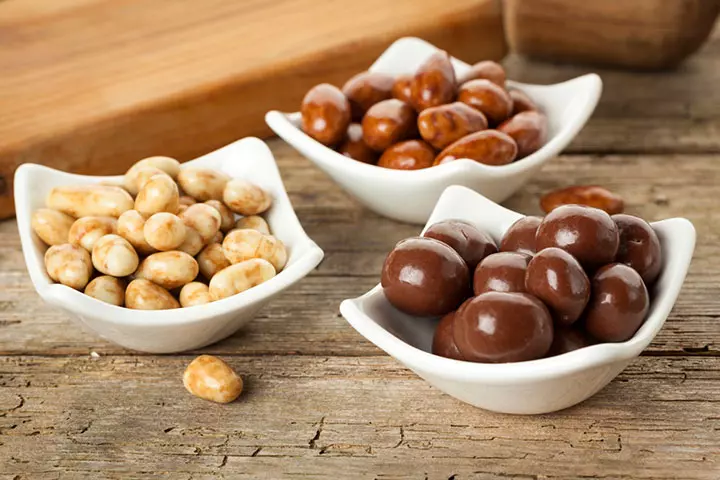
- Buy chocolates with little caffeine and no trans fat.
- Buy smaller bars of chocolate to limit sugar and fat intake.
- You can also get chocolate through chocolate-flavored biscuits, marshmallows, popcorn, cakes, and ice creams. But, these foods have more sugar and fat when compared to a bar of chocolate.
- Avoid using chocolate as a bribe or a reward to get your child to do something.
Frequently Asked Questions
1. How much chocolate should a child eat a day?
It is recommended that children eat no more than two to four squares of chocolate or a fun-size bar of chocolate once a week (7).
2. When can I give my child chocolate?
Although most children start eating chocolate after one year, it is recommended that you wait till after two years of age (7).
3. Can chocolate affect a child’s behavior?
Some parents believe that consuming chocolate can cause children to become hyperactive, but a 2006 study conducted by Australian researchers found that chocolate does not have any effect on behavior (8).
4. When should we avoid giving chocolates to kids?
Chocolate may contain milk, sugar, nuts, and dried fruits that can trigger allergies or contain contaminants (9). Therefore, it is essential to be aware of any allergies or sensitivities the baby may have and avoid giving them chocolate in such cases. It is also necessary to be cautious if there is a chance the baby may be allergic to specific ingredients in the chocolate.
5. How much caffeine is present in a bar of chocolate?
The average dark chocolate bar, weighing 100g, contains approximately 43 mg of caffeine (10).
Chocolates are a favorite among all children, and they will probably continue loving them even after they grow up. Share this post on chocolate for kids to help them understand the importance of chocolate, but ensure to give them chocolates in moderation to avoid tooth decay and teach them to wash their hands and mouth properly after having chocolates. You can also enjoy chocolates with your little ones and teach them the art of sharing.
Infographic: Fun Chocolate Facts For Children
Chocolates are a beloved treat for people of all ages. Whether you’re a child or an adult, there’s something about chocolates that just makes everything better. So if your little one loves chocolate as much as you do, why not share this infographic about chocolate facts with them? They’ll be amazed to learn about their tasty treat. And while you’re at it, why not enjoy a chocolate bar together as you learn more about this delicious food?
Some thing wrong with infographic shortcode. please verify shortcode syntax
Illustration: Chocolate For Kids - History Benefits And Fun Facts

Image: Stable Diffusion/MomJunction Design Team
Discover the fascinating history of chocolate in this video! Learn how chocolate has evolved over time and its impact on cultures around the world.
References
- Chocolate: Its Origins.
https://nhmu.utah.edu/articles/2025/05/chocolate-its-origins - Matthew P Pase et al.; (2013); Cocoa polyphenols enhance positive mood states but not cognitive performance: a randomized placebo-controlled trial.
https://pubmed.ncbi.nlm.nih.gov/23364814/ - Harvard Study: Dark Chocolate Can Help Lower Your Blood Pressure.
https://www.aarp.org/health/medical-research/info-03-2011/dark-chocolate-can-help-lower-your-blood-pressure.html - Alexander N Sokolov et al.; (2013); Chocolate and the brain: neurobiological impact of cocoa flavanols on cognition and behavior.
https://pubmed.ncbi.nlm.nih.gov/23810791/ - AHA: Limit children’s sugar consumption to 6 teaspoons per day.
https://publications.aap.org/aapnews/news/7400 - Dark chocolate: Half a bar per week to keep at bay the risk of heart attack.
https://www.eurekalert.org/news-releases/760578 - PORTION SIZES FOR CHILDREN 1 -4 YEARS.
https://infantandtoddlerforum.org/media/upload/pdf-downloads/1.3_-_Portion_Sizes_for_Children_1-4_Years.pdf - Ingram M. et al.; 2006; The effect of chocolate on the behavior of preschool children.
https://www.cambridge.org/core/journals/behaviour-change/article/abs/effect-of-chocolate-on-the-behaviour-of-preschool-children/1A7C72731C1EAF9260BD9A3B070D2902 - Dark Chocolate
https://nutritionsource.hsph.harvard.edu/food-features/dark-chocolate/ - FoodData Central.
https://fdc.nal.usda.gov/fdc-app.html#/food-details/170271/nutrients - Dark Chocolate Health Benefits.
https://health.clevelandclinic.org/dark-chocolate-health-benefits
Community Experiences
Join the conversation and become a part of our nurturing community! Share your stories, experiences, and insights to connect with fellow parents.
Read full bio of Abby Black
Read full bio of Swati Patwal
Read full bio of Rohit Garoo
Read full bio of Dr. Joyani Das





